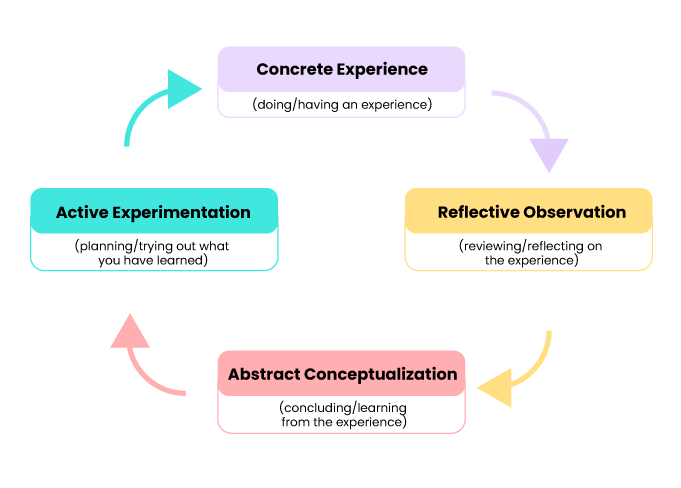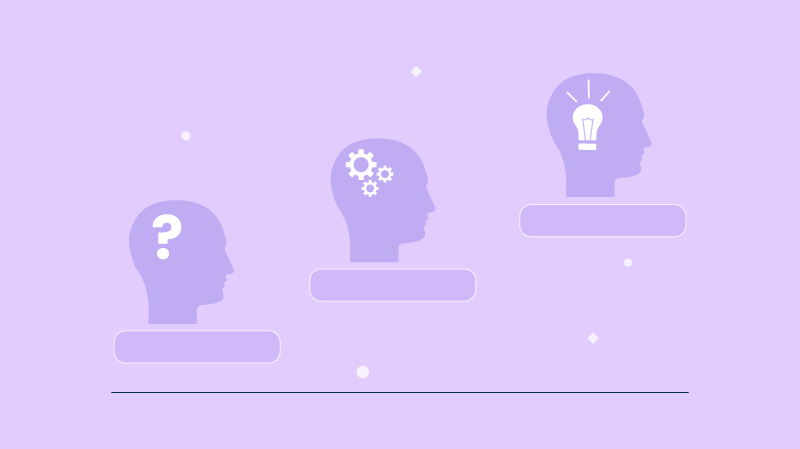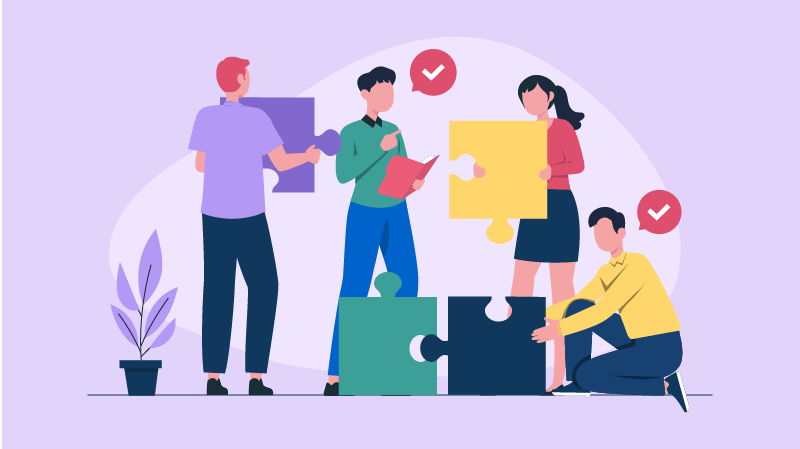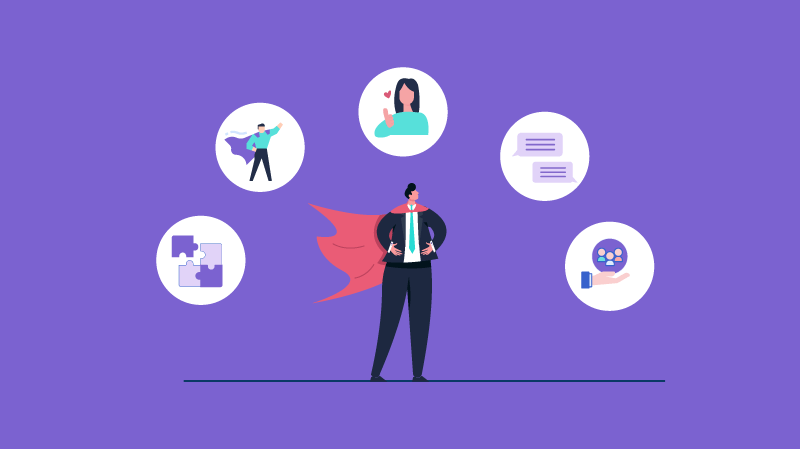A Brief Guide On Experiential Learning In The Workplace
"For the things we have to learn before we can do them, we learn by doing them," Aristotle stated in the Nicomachean Ethics around 350 BC.
The idea of learning via experience is a very old one. But, experiential learning is a much more recent technique.
Service-learning, is a type of experiential learning that promotes student engagement. It involves them in a cycle of service and reflection.
However, nowadays businesses are seeing the value of learning through "doing" and "experiencing. As a result, we're seeing a lot of them using the concept of experiential learning in the workplace.
What Is Experiential Learning In The Workplace?
Experiential learning boosts learners' willingness to learn. It generates more autonomous learners, expands knowledge/skill transfer to the workplace. It cultivates more meaningful learning when incorporated into corporate training programs.
In workplaces, experiential learning refers to learning and developing abilities through shared experience.
Even the most efficient training program spends roughly 30% of its time distributing knowledge to the learner. The remaining 70% of the time spent should allow them to apply what they have learned. And if your program is not marking up to this, you are not taking the best benefits of experiential learning.
There is one key distinction between experiential and academic learning. It is that the recipient gets more "real-life" experience in experiential learning.
We now have a lot of experiential business learning providers. It includes membership organizations that provide:
-
Peer group learning.
-
Professional business networking.
-
Expert/speaker sessions.
-
Mentorship.
-
Coaching as well as other services.
Importance of Experiential Learning In The Workplace
1. First and foremost, it inspires employee engagement
Experiential learning boosts employee engagement. It's because giving employees control over their own learning experiences allows them to become more engaged learners. When we give them opportunities for practice, feedback, and learning possibilities that they find interesting, they become self-motivated.
2. Gives opportunity to prepare for the future
Authentic experiential learning aids in future preparation. It provides the most effective way to learn real-world skills by putting concepts into reality through hands-on learning. Perhaps, for this reason, schools are now incorporating experiential learning strategies to assist youngsters in preparing for the future workplace.
3. It is economically feasible
Experiential learning is unique, especially because it is inexpensive. Infact, reducing costs tend to enhance rather than hinder learning experiences for employees. There are many cheap or free learning materials available for experiential learning. Apart from that, you need a stimulating learning ecosystem, a dedicated team, and possibly some experiential learning tools or templates that set a framework for learning.
4. It boosts your diversity efforts
For L&D teams, using an experiential learning method can be a wonderful way to increase workplace diversity. You can use it in an unconscious bias case study. Participants work on a fictitious situation and experience and observe their biased reactions (which remain confidential). Learners "feel" the issue and have an emotional response in addition to an intellectual one, which has been shown to increase retention significantly.
5. Can adapt to employees’ learning styles
You can tailor experiential learning to the participants' learning styles. Some people learn visually, while others like to learn by action, and so on. As a result, learners can tailor their learning styles to their strengths. They can also work on their flaws to make them less noticeable.
6. Recognizes the value of self-directed learning
Experiential learning coaches, unlike regular teachers, do not give their students all the answers; instead, they allow them to experiment and learn firsthand. It entails assisting people in discovering their solutions by assimilating new information and abilities.
Kolb's Experiential Theory

David A. Kolb gave us the most contemporary theory of experiential learning in the 1970s. It dwells on the work of John Dewey, Kurt Lewin, and Jean Piaget.
His theory offers a more holistic approach to learning. It emphasizes how experiences influence the learning process. It considers factors such as cognition, contextual circumstances, and emotions.
"I hear, and I forget. I see, and I remember. I do, and I understand."
The crux of Kolb's thesis is based on the above quote by Confucius. And, it says that a person best learns through action.
Kolb's experiential learning theory has two components:
-
a four-stage learning cycle
-
four distinct learning styles
The learner's internal cognitive processes heavily influence Kolb's theory.
Kolb's approach is particularly intriguing. It is because of its ability to emphasize the learner's point of view and personal growth.
Kolb states that learning involves the practical experience of abstract concepts. It is something that you can apply in various situations. According to his theory, the urge to create a new concept is fueled by a one-of-a-kind experience.
"Learning is the process whereby knowledge is created through the transformation of experience" (Kolb, 1984, p. 38).
Let's take a look at Kolb's experiential learning cycle.
The 4 Stage Learning Cycle By Kolb
1. Concrete Experience
In the first phase of the cycle, one has the experience that underlies observation. Individuals encounter new experiences that create opportunities to learn. According to Kolb's theory, one cannot learn by simply observing or reading. The purpose is to enable individuals to take part in activities. And in the long run, they can learn from the experience.
2. Reflective Observation
In the second stage, one looks back on the experience before deciding how to proceed. Special attention is paid to the discrepancy between experience and understanding. The goal is to examine the situation and assess the experience.
3. Abstract Conceptualization
In abstract conceptualization, individuals develop theories to explain their experiences. This analysis often leads to new ideas or modifies existing concepts. This phase identifies recurring concerns or issues useful for new learning experiences. The goal is to create a concept that one can apply in the future.
4. Active Experimentation
In the end, individuals apply what they learned during the experience. They can use it in a variety of situations. They can use their theories to resolve problems, make decisions, and influence people. The learner takes risks and uses a strategy to determine the outcome (experimentation). The goal is to check the concepts in many new situations to find ways to enhance them.
Experiential Learning Examples In The Workplace
-
One can use simulation to train new employees or see how a new employee reacts to certain situations.
-
Call center employees can take up role-playing games with their colleagues. It may be beneficial for training purposes.
-
Simulations are great in helping employees in the construction industry. It helps them react to emergencies like (e.g., earthquakes or other natural disasters). It gives them a better understanding of any situation. Thus, making them better problem solvers.
-
On-the-job training is always much better than teaching theories in training sessions.
These experiential learning instances emphasize learning by doing rather than theoretical learning approaches. You can use them as an essential part of your total employee training program.
9 Best Experiential Learning Activities For Workplaces
1. Role-playing
Role-playing might be as simple as having a learner answer a fictitious phone from a difficult client.
You can also design it to assist employees in understanding different job challenges. For example, a client service manager can pretend to be a customer. Or a manager can pretend to be an employee to understand how a particular way of speaking would influence others.
Role-playing provides a safe setting for employees to encounter a variety of scenarios. It encourages to make and learn from mistakes, and gain practical experience. It represents real-life experiences, problems, failures, and outcomes using real-life scenarios.
This strategy builds confidence, develops skills, and inspires learners to handle different business challenges.
2. Games
Gaming is a popular way to assist employees in learning by doing. Individuals and organizations can interact in games by cooperating or competing. The games are generally based on real-life situations
This method can offer employees important lessons about handling difficult situations. In this experiential training strategy, you can provide motivational elements. Employee reward points, badges, and certificates make the game more interesting.
Above all, such team-building activities are entertaining as well as instructional. There are a variety of fun games for workplaces. It helps participants bond and learns to work together in a fun yet dynamic way.
Employees can play games like Office Trivia, Shark Tank, and Powerpoint Karaoke. All these games provide challenges connected to certain abilities, goals, and outcomes.
Team problem-solving activities also provide great experiential learning scopes. It emphasizes the value of clear workplace communication, teamwork, and the ability to listen.
Read our blog on: Active Listening: Its Skills and Importance in the Workplace
3. Case Studies
Case studies are based on actual events that have occurred in the past. As we all know, many people learn better through cases than from fundamental rules.
Cases can take many different forms, ranging from a simple "What would you do in this case?" query to a thorough description of an event with a data test.
Case studies can be presented in various ways. Participants can have the opportunity to react to open-ended questions and brainstorm solutions. They can also study and comprehend information in case studies.
4. Problem-Solving Through Gamification
Gamification is entertaining, informative, and enjoyable, producing astounding outcomes. Employees learn to innovate to solve complex problems in the game environment.
Outside-the-box thinking aids companies in effectively adapting to unpredictable conditions. It increases a company's and its management team's survivability.
The gamification method can be a fantastic problem-solving tool for corporations. Gamification allows learners to see a problem from a different perspective. It gives them a new view and enhances their critical thinking skills.
Gamification in the workplace doubles up the learner engagement immediately. It boosts the learner's confidence before they enter the real world.
Your sales team, for example, can use the virtual experience to practice getting leads. The game-oriented atmosphere helps people think and identify the best answers to problems.
5. On The Job Training
Most employees learn in a setting that requires them to put their knowledge and skills to use. On the job trainings guides employees to use current workplace tools, machines, and documents. All these come along with the expertise to do their responsibilities efficiently.
You can provide job training in a variety of ways. Job rotation and apprenticeship training are two common practices here.
Besides industry leaders, managers can train staff. Employees can better relate to the actual operation based on the manager's competence. As such, they can grasp corporate complexities. As a result, employees become more interested and engaged.
6. Corporate Philanthropy
Nowadays, employees are more likely to stay with a company if they believe in its mission. Apart from financial stability, they look forward to taking corporate social responsibilities. Corporate philanthropy is a wonderful way to make this connection. It encourages your employees to take part in corporate charity in a variety of ways.
It boosts your company's brand positioning as a great place to work. It demonstrates to employees that their employer cares about them. It also implies that they share their social beliefs. You must be visible, and promote the program to make it evident that you offer your full support.
7. Sensitivity Training
Sensitivity training is given to employees to help them become self-aware.
Its goal is to help employees or trainees see themselves through others' perspectives. It helps to improve the trainees' self-esteem and interpersonal habits. It can also help to cut negativity in the workplace. Many global companies use this top-management training method.
8. Lunch and Learn
The workplace is frequently viewed as a place where people can't be themselves. They're expected to keep their personal lives separate. But expressing themselves might help coworkers connect and relate to one another.
Companies that use Lunch and Learn activities encourage employees to discuss what they've lately learned with one another. It can be anything ranging from a personal experience to a professional one. It could also be a tale about a successful leader. Employees become more open and willing to disclose where they've failed. They can also discuss how they overcame a certain problem.
The most important thing here is to create a healthy psychological environment. It must help learning and development along with developing personal connections among employees.
Lunch and Learns are best because employees can share what they've done in a secure environment. It also allows for criticism and evaluation. It is especially perfect for businesses that wish to foster a culture of constant learning.
9. Simulation
You can use simulations to imitate real-world professional challenges. It involves participants interacting with electronic, software-based activities in real and virtual environments.
Simulations can test abilities, and allow employees to put lessons into practice. Participants get the chance to practice specific skills. They are very adaptable and prepare participants for both expected and unforeseen events.
Simulations are great because they allow employees to fail in a controlled environment. It doesn't matter if they make errors or perform poorly during training. In simulations, you can encourage employees to be experimental without fear of failing.
2 Exciting Uses Of VR Simulations
The famous VR simulation supplemented KFC's extensive, multi-step employee training program. The immersive VR experience integrates playful design and game mechanics. One such appealing virtual reality is their Escape Room concept.
The players complete the five main procedures to manufacturing KFC chicken. It includes inspecting, rinsing, breading, racking, and pressure frying the chicken. Once done, they exit the secret training kitchen. This VR gives an excellent glimpse of what goes into preparing the authentic KFC chicken.
Let's take another example.
ExxonMobil uses VR for safety training. It teaches some important lessons to oil and gas industry employees. One of these simulations involves employees being virtually transported to a liquified natural gas tanker's loading dock. They spend time coping with various circumstances in the location.
This, of course, allows them to improve their talents and sharpen their intuition. It results in a safer working environment.
In Conclusion
Experiential learning is now used by many of the top Fortune 500 businesses. It helps to provide them with the skills they need to succeed in the business world.
It is specifically very engaging for today's audience with smartphones.
When participants receive a notification on their phones during lectures, they often leave.
But, experiential learning is a truly immersive experience. It's engaging enough to hold people's attention and keep them focused on the task at hand. Trainees will want to participate because it is entertaining. And they will not be distracted by their phones.
Experiential educators have long claimed to support student-centered learning. Although their beliefs are teacher-centered, as proven in practice. Teachers must be able to provide life-changing learning opportunities. While doing so, they should also nurture relationships with their students. They must be able to recognize and apply various strategies while solving problems.
A similar concept applies to the experiential learning process in business. Employers should take an active role in encouraging trainees' active involvement and immersion.
Experiential learning activities are customizable to different corporate training programs. We can use it for any business training project. We can include it in all types of corporate training programs to yield best results.


















